Hormone Replacement and Stroke Risk
Stroke and its connection to estrogen replacement therapy have become increasingly discussed topics in recent research, shedding new light on their implications and controversies.
One notable study that garnered attention is the Harvard Nurses’ Health Study, which has been tracking 121,700 women since 1976. Among current users of hormones, there was an intriguing finding: a 30% decrease in stroke-related deaths. However, due to the relatively small number of stroke cases (167) compared to deaths from heart disease and cancer, drawing firm conclusions requires further investigation.
It’s important to note that estrogen replacement therapy is not recommended for women with a history of serious or recurrent blood clotting issues, as higher doses (similar to those found in birth control pills) can increase the risk of clot formation. Additionally, doctors are cautious about prescribing birth control pills to young women who smoke, as this combination leads to a heightened risk of stroke and heart attack.
Young individuals who experience a stroke undergo thorough examinations to identify abnormalities in the clotting system. For instance, deficiencies in protein S, protein C, antithrombin III, and plasminogen can contribute to clotting disorders. Studies have also shown that 45% of young stroke victims have antiphospholipid antibodies in their blood. Doctors must assess these coagulation risks when evaluating stroke cases in young individuals who may have been on estrogen therapy.
Insights into Growth Hormone and Height Potential

Growth hormone, which was initially extracted from human cadavers, was discovered in 1956 and used to cure dwarfism two years later. Subsequently, genetically engineered growth hormones gained approval in 1985.
Although true growth hormone deficiency is rare, affecting around 20,000 children in the country, it necessitates daily injections of growth hormone. These injections have no notable side effects but come at a substantial cost, ranging from $15,000 to $40,000 annually.
While growth hormone treatment may not have a substantial impact on “normal” children’s height, studies have looked into its effects on “severely short” but otherwise healthy youngsters. According to some research, such treatment can add an average of three inches to their anticipated adult height, potentially minimizing the psychological anguish associated with short stature. More research, however, is required to support this hypothesis.
To assess a child’s potential height, medical professionals consider the child’s parental height and compare the child’s growth to that of other children of the same age. Being in the lower 1% on the growth charts does not necessarily indicate a growth hormone deficiency, as the range includes both the lowest and highest extremes of normal height.
Typically, doctors closely evaluate a child’s growth chart to make informed decisions about growth hormone therapy. Many children do not require further workup, while others may undergo monitoring for about a year before considering growth hormone therapy.
Human Growth Hormone (HGH): Growth and Metabolism Regulation
Human Growth Hormone (HGH) is a hormone naturally produced by the pituitary gland, with vital roles in promoting growth during childhood, maintaining adult body structure, and influencing metabolism in both children and adults.
What is Human Growth Hormone (HGH)?
Human Growth Hormone (HGH), commonly known as somatotropin, is a pituitary gland hormone. The gland is located at the base of the brain. As a tiny protein, HGH serves an important role in encouraging growth and development.
How Does HGH Work?
HGH works by sending messages through circulation to organs, muscles, and tissues. It promotes bone, muscle, and tissue growth while also regulating metabolism—the body’s conversion of food into energy.
What Are the Advantages of Human Growth Hormone?

HGH has various advantages, including improved growth and development in youngsters.
- Adults’ muscle bulk and strength have increased.
- Body fat is being reduced.
- Skin health has improved.
- Energy levels have increased.
- Sleep quality has improved.
HGH serves two primary functions in the body:
Stimulating Growth: During childhood, HGH triggers growth in various tissues and organs, particularly cartilage and bones. However, once the growth plates fuse, HGH no longer contributes to an increase in height. Instead, it helps maintain body structure throughout adulthood.
Impacting Metabolism: HGH influences metabolism by increasing the production of insulin-like growth factor 1 (IGF-1), which manages the effects of HGH in the body. IGF-1 has glucose-lowering effects similar to insulin, helping to regulate blood sugar levels. However, excessive HGH levels can counteract the effects of insulin, leading to elevated blood glucose levels.
Can HGH Make You Taller?
HGH is essential for promoting vertical growth in children, but once the growth plates fuse and a person reaches their final height, HGH cannot increase height further. Instead, it continues to play a vital role in maintaining body structure and metabolism.
Understanding Normal HGH Levels
HGH levels vary throughout the day and depend on age and sex. Normal HGH levels are typically between 0.4 and 10 nanograms per millilitre (ng/mL) or 18 and 44 picomoles per liter (pmol/L) in adults who were born with a male gender preference.
For adults assigned female at birth, the range is usually 1 to 14 ng/mL, or 44 to 616 pmol/L. In children, normal HGH levels range from 10 to 50 ng/mL, or 440 to 2200 pmol/L. These values may vary slightly between different laboratories.
Low HGH Levels and Growth Hormone Deficiency
When HGH levels are lower than normal, it can result in growth hormone deficiency, often due to issues with the pituitary gland, leading to hypopituitarism—a condition where one or more hormones produced by the pituitary gland are deficient. Growth hormone deficiency affects adults and children differently, and treatment may be necessary to address the deficiency based on individual cases.
Understanding the role of Human Growth Hormone (HGH) in growth and metabolism is crucial for identifying potential health issues and ensuring appropriate hormone levels for overall well-being.
Polycystic Ovary Syndrome (PCOS) Management: Diet and Facial Hair

Polycystic Ovary Syndrome (PCOS) affects many women, causing irregular periods, obesity, and facial hair growth due to excess secretion of androgens, often called “male” hormones. Aside from the visible symptoms, PCOS poses significant health risks, including a higher chance of developing diabetes, heart disease, and cancer.
To manage PCOS effectively, a diet that promotes weight reduction is crucial, as obesity exacerbates the hormone imbalance and increases the risk of diabetes. Additionally, certain medications, like Spironolactone, may be prescribed to block androgens, potentially reducing facial hair growth.
For regulating periods and managing PCOS symptoms, birth control pills can be beneficial. However, existing facial hair may require additional interventions, such as bleaching, depilatories, shaving, waxing, plucking, or laser treatments. While laser techniques can provide temporary relief, they may not be as effective for blond hair and can be relatively costly.
In summary, recent research has brought valuable insights into hormone replacement therapy, growth hormone treatment, and PCOS management. As new studies emerge, we can expect further advancements in understanding and addressing these medical concerns.














